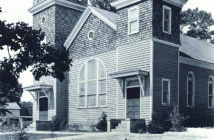FORT LEE, Va. – Fort Lee commemorates its centennial in 2017 with a variety of activities that honor both its rich history and the lineage of troops, family members, and civilians who contributed to a century of support to the nation.
Celebration plans in July include a community concert at the annual Fourth at the Fort celebration, a time capsule ceremony, the unveiling of a commemorative print, museum exhibit openings, and a documentary premiere.
“For 100 years, Camp/Fort Lee has provided world-class training to the brave men and women of the U.S. Armed Forces,” said Maj. Gen. Darrell K. Williams, commanding general of the U.S. Army Combined Arms Support Command of Fort Lee.
Following a declaration of war in April 1917, the Army  leased 9,000 acres in Prince George County for the construction of one of 32 new cantonments to train the mobilizing Army. Following a whirlwind of construction, Camp Lee became the home of the 80th Division, which deployed to France in May 1918 in support of World War I. Daily, more than 40,000 troops trained at Camp Lee until the Armistice in November 1918.
leased 9,000 acres in Prince George County for the construction of one of 32 new cantonments to train the mobilizing Army. Following a whirlwind of construction, Camp Lee became the home of the 80th Division, which deployed to France in May 1918 in support of World War I. Daily, more than 40,000 troops trained at Camp Lee until the Armistice in November 1918.
Serving as a demobilization
station until 1921, Camp Lee was dismantled, with the land reverting to the Commonwealth for use as a forest and game preserve. It would remain so until war again threatened the nation.
In the Army’s build up to World War II, Camp Lee was reconstructed in October 1940, becoming home of the Army Quartermaster Corps. The camp was also briefly the home of the Women’s Army Corps Training Center.
Camp Lee became Fort Lee when it was designated as a permanent Army facility in 1950 and continued to serve as the home of the Quartermaster until 2005. That year, Fort Lee’s role for the Army was significantly expanded after the passing of the Base Realignment and Closure Act.
Under the 2005 BRAC, the Ordnance Mechanical Maintenance School at Aberdeen Proving Ground, Md., and the Ordnance Munitions and Electronic Maintenance School at Redstone Arsenal, Ala., were relocated to Fort Lee. These elements moved to a newly constructed U.S. Army Ordnance School Campus on Fort Lee in 2009. The U.S. Army Transportation School also relocated to Fort Lee from Fort Eustis. The Combined Arms Support Command headquarters building, several troop barracks facilities, housing and other new facilities constructed at Fort Lee also greatly expanded the post as part of the BRAC.
Maintenance School at Aberdeen Proving Ground, Md., and the Ordnance Munitions and Electronic Maintenance School at Redstone Arsenal, Ala., were relocated to Fort Lee. These elements moved to a newly constructed U.S. Army Ordnance School Campus on Fort Lee in 2009. The U.S. Army Transportation School also relocated to Fort Lee from Fort Eustis. The Combined Arms Support Command headquarters building, several troop barracks facilities, housing and other new facilities constructed at Fort Lee also greatly expanded the post as part of the BRAC.
As the Army’s “Home of Sustainment,” Fort Lee supports the training, education and development of adaptive Army professionals in fields such as transportation, supply, culinary arts, equipment repair and maintenance.
“There are two reasons Fort Lee has remained a vital installation for the Army,” Williams noted. “From the very beginning, we have consistently delivered game-changing troops and leaders, and leveraged an unshakeable partnership with our surrounding community.”
Fort Lee is now the third largest training center in the Army, supporting nearly 86,000 Soldiers, retirees, veterans, family members and civilian employees both on and off post. The installation has a $2.4 billion impact on the local economy each year.
The major organizations at Fort Lee include the Defense Commissary Agency, the Defense Contract Management Agency, the Combined Arms Support Command, Army Logistics University, the U.S. Army Ordnance School, U.S. Army Quartermaster School and the U.S. Army Transportation School.

